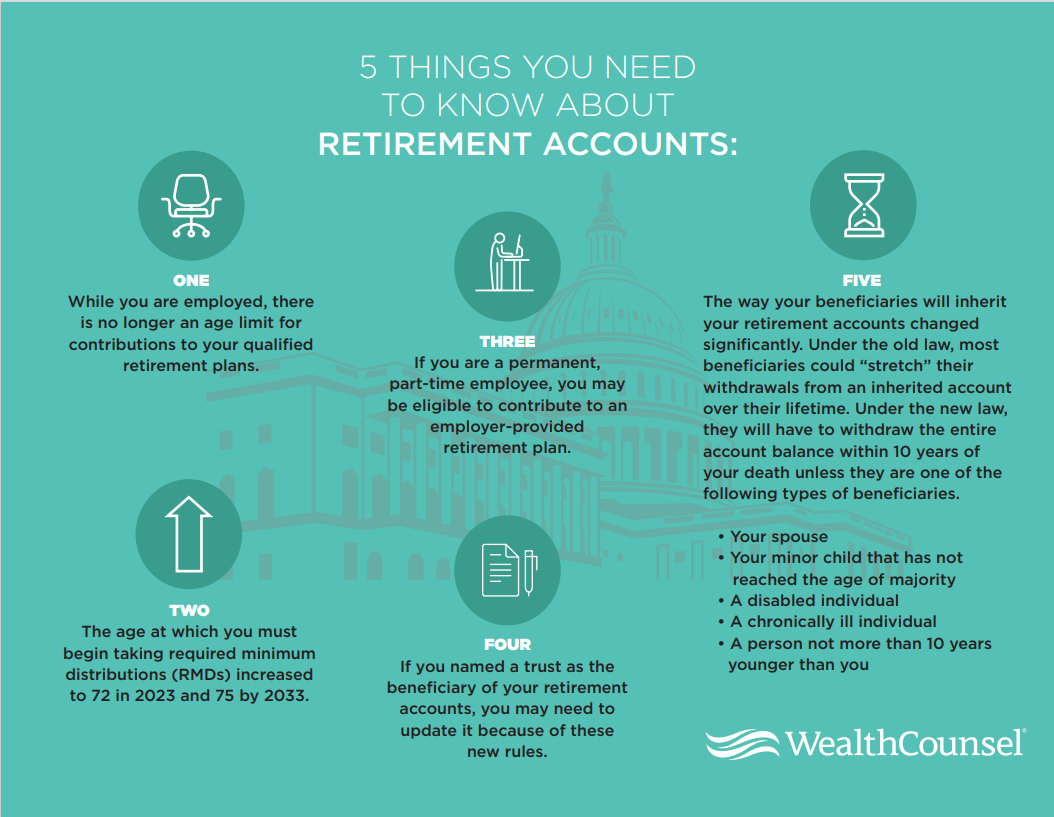SECURE 2.0 Act: How It Affects You and Your Retirement Account Beneficiaries
On December 29, 2022, President Biden signed the Setting Every Community Up for Retirement Enhancement 2.0 Act (SECURE 2.0 Act). The previous SECURE Act in 2020 made several changes to retirement planning:
- It increased the required beginning date (RBD) for required minimum distributions (RMDs) from your retirement accounts from 70 ½ to 72 years of age.
- It eliminated the age restriction for contributions to qualified retirement accounts.
- It requires that most designated beneficiaries withdraw the entire balance of an inherited retirement account within ten years of the account owner’s death.
Eligible Designated Beneficiaries Exempt from the 10-Year Rule
The old SECURE Act provided a few exceptions to the mandatory 10-year withdrawal rule with a list of eligible designated beneficiaries:
- Spouses
- Beneficiaries who are not more than ten years younger than the account owner
- The account owner’s children who have not reached the age of majority
- Disabled individuals and chronically ill individuals
New Provisions in the SECURE 2.0 Act
The SECURE 2.0 Act made several enhancements to clarify the original legislation. Several of the key enhancements are summarized below:
- It raises the RBD age for RMDs to 73 in 2023 and 75 by 2033.
- It decreases penalties for not taking RMDs to 25 percent of the RMD amount and ten percent of IRAs if corrected timely.
- Employees will be automatically enrolled in 401(k) and 403(b) plans but may opt out within 90 days.
- Higher catch-up contributions are allowed for participants over 50 ($7,500 in 2023).
- There is more flexibility in annuity payments paid from qualified retirement plans.
- Early distributions are permitted for long-term care contracts without penalty.
- Qualified charities can be named as remainder beneficiaries after the death of a disabled or chronically ill beneficiary without disqualifying the trust as a see-through trust.
- Plan sponsors may match contributions made on student loan repayments on the same vesting schedule as elective deferrals, effective 2024.
- 529 plans maintained for at least 15 years may be rolled into a Roth IRA with a $35,000 lifetime limit, effective 2024.

Exceptions To The Early Distribution Rule
The SECURE 2.0 Act allows exceptions to the ten percent early distribution excise tax, including the following:
- Qualified births and adoption expenses
- Terminally ill individuals
- Federally declared disasters
- Emergency personal expenses
- Domestic abuse victims
The new provisions and exceptions in the SECURE 2.0 Act may change the decisions you have made for your intended beneficiaries and alter the path to achieving your long-term goals.
Under the old law, beneficiaries of inherited retirement accounts could take distributions over their individual life expectancy. Under the SECURE Act and SECURE 2.0 Act, the shorter 10-year time frame for taking distributions will accelerate income tax due, possibly bumping your beneficiaries into a higher income tax bracket and causing them to receive less of the funds in the retirement account than you may have originally anticipated. Eligible designated beneficiaries exempt from the 10-year rule may still have the opportunity to benefit from future retirement plan growth.
Your estate planning goals likely include more than just tax considerations. You may also be concerned with protecting a beneficiary’s inheritance from their creditors, future lawsuits, and a divorcing spouse. In order to protect your hard-earned retirement account and the ones you love, it is critical to act now.
Review Your Revocable Living Trust Or Standalone Retirement Trust
We may have addressed the distribution of your retirement accounts in your living trust, or we may have created a retirement trust that would handle your retirement accounts at your death. Your trust may have included a conduit provision, which requires that retirement distributions be immediately distributed to or for the benefit of the beneficiaries (rather than being held in trust). With the SECURE Act’s passage, a conduit trust structure may not be the best choice any longer because the trustee will be required to distribute the entire retirement account balance to most types of beneficiary within 10 years of your death (which, as discussed above, can create an income tax headache for the beneficiary).
Under the current rules, if a person dies prior to their required beginning date for RMDs, then designated beneficiaries will not be required to take out RMDs during the 10-year payout period (but would need to take full distribution by the end of the 10-year payout period). However, if the person died after their required beginning date, the beneficiary must continue to take out RMDs on an annual basis (with full distribution at the end of the 10-year payout period).[1] We should discuss the benefits of an accumulation trust, an alternative trust structure through which the trustee can take any required distributions and continue to hold them in a protected trust for your beneficiaries.
[1] Different distribution rules may apply to different types of beneficiaries, and eligible designated beneficiaries may be subject to different rules.
Consider Additional Trusts
For most Americans, a retirement account is the largest asset they will own when they pass away. If we have not done so already, it may be beneficial to create a trust to handle your retirement accounts. While many accounts offer simple beneficiary designation forms that allow you to name an individual or charity to receive funds when you pass away, this form alone does not take into consideration your estate planning goals and the unique circumstances of your beneficiary. A trust is a great tool to address the mandatory 10-year withdrawal rule under the SECURE Act, providing continued protection of a beneficiary’s inheritance.
If you have beneficiaries with a disability or chronic illness, you may want to consider a special needs or supplemental needs trust. Beneficiaries are exempt from the mandatory 10-year payout rule, giving them more time for the retirement account to grow tax-deferred.
Review Intended Beneficiaries
With the changes to the laws pertaining to retirement accounts, now is a great time to review and confirm your retirement account information. Whichever estate planning strategy is appropriate for you, it is important that your beneficiary designation is filled out correctly. If your intention is for the retirement account to go into a trust for a beneficiary, the trust must be properly named as the primary beneficiary. If you want the primary beneficiary to be an individual, they must be named on a beneficiary designation form. You should ensure that you have listed contingent beneficiaries as well.
If you have recently divorced or married, you will need to ensure that the appropriate changes are made to your current beneficiary designations. At your death, in many cases, the plan administrator will distribute the account funds to the beneficiary listed, regardless of your relationship with the beneficiary or what your ultimate wishes might have been.
Other Strategies
Although these new laws may be changing the way we think about retirement accounts, we are here and are prepared to help you properly plan for your family and protect your hard-earned retirement accounts. If you are charitably inclined, now may be the perfect time to review your planning and possibly use your retirement account to fulfill your charitable desires.
A charitable remainder trust can use annuity and unitrust payments to mimic the “stretch” provided by using life expectancy. Assets are funded into the trust and then liquidated or sold by the trust. The money from the sale is then invested to produce a stream of income. The sale avoids capital gains tax at the trust level because the trust is liquidating the account and is tax-exempt. However, the noncharitable recipient of the income stream will still be responsible for income tax on the distributions. In contrast, you may distribute your entire retirement asset directly to a charity, and they will not have to pay tax on the income from the plan. Additionally, If you have a significant estate, there may be an estate tax charitable deduction.
Following the recent changes to the SECURE Act, you may be concerned about the amount of money that will be available to your beneficiaries following your death and the impact that the potential accelerated income tax may have on that ultimate amount. We can explore different strategies with your financial and tax advisors to infuse your estate with additional cash upon your death.
Give us a call today to schedule an appointment to discuss how your estate plan and retirement accounts might be impacted by the SECURE Act and SECURE 2.0 Act.
What next?
If you think it might be time to think through your estate plan, you can:
- Call 720-821-7604 to schedule an "Attorney Evaluation Session," to determine whether our firm would be a good fit for your needs. Or fill out our contact form to have us call you.
- Visit our estate planning page to learn how proactively thinking through your estate plan can protect you and your family, minimize hassle, lower the chance of family discord, and minimize or eliminate taxes.
- Learn more by reading our blog or watching our videos.










